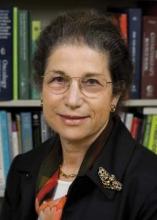BOSTON – For some, the words “palliative care” evoke thoughts of pain- and anxiety-relieving therapies at the end of life, when all other treatments have failed. But in fact, palliative care is, or should, be an integral part of cancer therapies from the outset, say experts in the care of cancer survivors.
“From the beginning, at the time of diagnosis and staging, we need to be thinking about palliative care,” said Dr. Patricia A. Ganz, director of Cancer Prevention and Control Research and the Patients and Survivors Program Area at the Jonsson Comprehensive Cancer Center, University of California, Los Angeles.
The ultimate aim of palliative care should be research and development of strategies to prevent the long-term and late effects of cancer treatment, she said at the Palliative Care in Oncology Symposium.
Long-term effects are symptoms or problems that begin during cancer treatment and persist when treatment ends, such as fatigue, cognitive complaints, or pain.
Late effects are those that may occur months or years after the end of therapy, such as second cancers, lymphedema, or congestive heart failure.
Dr. Ganz said that it is essential for oncologists to understand the biologic mechanisms of symptoms in order to provide validity and support for patient complaints, develop possible pharmacologic or behavioral solutions, and possibly prevent the development of symptoms in at risk patients. In addition, it is important to understand the potential relationships between symptoms, tumor biology, and disease progression.
Cancer-related fatigue
“Fatigue is an extremely common and distressing side effect of cancer and its treatment. We expect fatigue during treatment, anywhere from 60% to 90% of patients report moderate to severe symptoms of fatigue, and it can sometimes be a treatment-limiting side effect. But what many people are not prepared for, especially patients, is that it may continue after they have completed their primary treatment,” said Julienne E. Bower, Ph.D., of the departments of psychology and psychiatry/biobehavioral sciences at the University of California, Los Angeles.
“Perhaps because they feel like this is something that they are supposed to endure, because they have had this great and hopefully successful treatment for cancer, they often don’t talk about it with their clinicians and physicians, and fatigue is often undertreated. This may be in part because we don’t really understand the mechanisms underlying fatigue,” she said.
ASCO has developed and will soon publish evidence-based clinical practice guidelines for the screening, assessment, and management of cancer-related fatigue. The guidelines apply to patients who have completed therapy with curative intent, rather than patients currently in therapy.
Dr. Bower, who cochaired the guideline development committee, says the most important recommendation is that screening for fatigue should be a regular part of cancer follow-up. Patients with no or only mild fatigue, rated 0-3 on an analog scale, should continue to be monitored at subsequent follow-up visits. Patients with moderate to severe fatigue (4-10) should have a comprehensive fatigue assessment that includes a focused history of fatigue and evaluation of disease status, assessment for potential contributing factors such as medications or comorbidities such as depression, and, if warranted, laboratory evaluation.
The guidelines emphasize that all patients need counseling and education about fatigue, its persistence and prevalence, and general strategies for preventing or managing it, such as physical activity.
Patients with moderate to severe fatigue should be evaluated and treated for contributing factors. These patients may require more intensive treatments. Evidence from the literature supports recommendations for exercise, psychosocial therapies such as psychoeducation and cognitive behavioral therapy, and mind-body treatments such as yoga, acupuncture, and mindfulness, Dr. Bower said at the symposium cosponsored by AAHPM, ASCO, ASTRO, and MASCC.
Inflammation fingered
“The problem here is that we don’t really know what causes fatigue, so we’re taking all these different approaches, nonspecific approaches, and I think we have been fortunate to have been having some positive effects. But obviously if we know what the mechanisms are and we know what the risk factors are, we’re going to be able to deliver much more targeted and effective interventions” she commented.
One area of particular interest is inflammation, which can be triggered when immune cells release proinflammatory cytokines (such as interleukins 1 and 6, and tumor necrosis factor–alpha) in response to cancer treatments, infection, and injury.
“These cytokines move their way up to the brain and they cause a variety of behavioral changes, including fatigue,” she said.
This hypothesis is supported by evidence that many patients who have posttreatment fatigue have elevated levels of inflammatory markers,” and we see this across the survivorship trajectory.”


